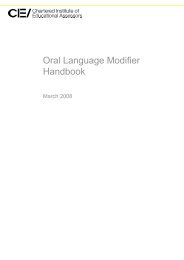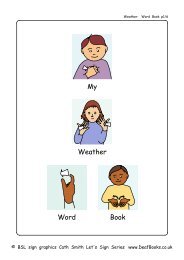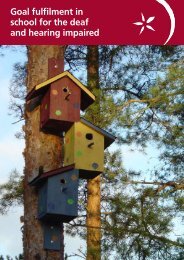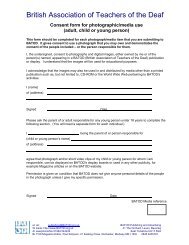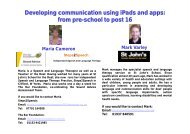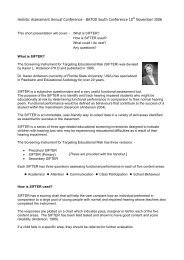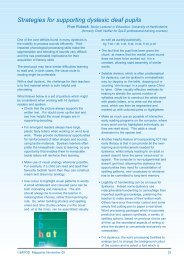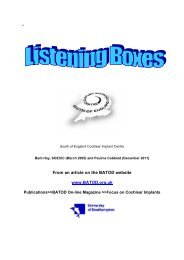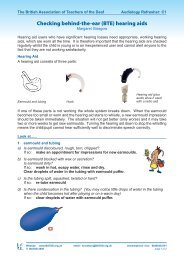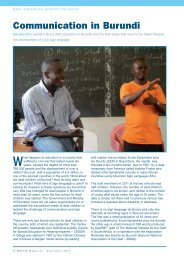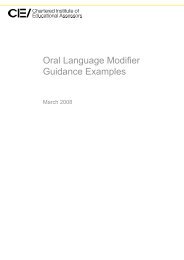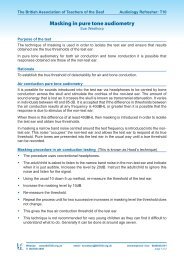Assessing deaf children's development in Emotional Literacy
Assessing deaf children's development in Emotional Literacy
Assessing deaf children's development in Emotional Literacy
Create successful ePaper yourself
Turn your PDF publications into a flip-book with our unique Google optimized e-Paper software.
<strong>Assess<strong>in</strong>g</strong> <strong>deaf</strong> children’s children s<br />
<strong>development</strong> <strong>in</strong><br />
<strong>Emotional</strong> <strong>Literacy</strong>
Why do we need to know about<br />
this?<br />
�� There is a great deal of research & assessments<br />
available for <strong>deaf</strong> children’s children s <strong>development</strong> <strong>in</strong><br />
language – both written & spoken.<br />
�� There are also valid assessments for Numeracy, Numeracy,<br />
Science & other curriculum subjects available.<br />
�� There is NO assessment tool to measure how<br />
<strong>deaf</strong> children become more aware of how they<br />
feel, respond to how others feel & to social<br />
situations.
The purpose of my study with<br />
<strong>deaf</strong> children aged between 8 – 9<br />
years old<br />
�� To <strong>in</strong>crease self-esteem self esteem &<br />
self- self confidence<br />
�� To understand and use<br />
vocabulary of emotions and<br />
emotional states<br />
�� To recognise and <strong>in</strong>terpret<br />
feel<strong>in</strong>gs, reactions and<br />
po<strong>in</strong>ts of views of self &<br />
others
Why is it important for <strong>deaf</strong><br />
children to learn <strong>Emotional</strong><br />
<strong>Literacy</strong> skills?<br />
�� Much research shows<br />
<strong>deaf</strong> children at higher<br />
risk of emotional &<br />
behavioural difficulties<br />
than hear<strong>in</strong>g children.<br />
�� Directly attributed to the<br />
consequences of be<strong>in</strong>g<br />
<strong>deaf</strong>, not to be<strong>in</strong>g <strong>deaf</strong>.
<strong>Emotional</strong> & Social<br />
Development<br />
�� Necessary to look at both areas together.<br />
�� Delay <strong>in</strong> language & communication skills<br />
leads to limited social skills with both<br />
hear<strong>in</strong>g & <strong>deaf</strong> peers.
How can <strong>Emotional</strong> <strong>Literacy</strong><br />
1) peers<br />
help with social skills?<br />
�� Better relationships with: with<br />
peers <strong>in</strong> learn<strong>in</strong>g how to make<br />
& keep friends<br />
parents <strong>in</strong> <strong>in</strong>teract<strong>in</strong>g &<br />
communicat<strong>in</strong>g their needs &<br />
feel<strong>in</strong>gs<br />
people <strong>in</strong> their community so<br />
they learn to live & work with<br />
others.<br />
2) parents<br />
3) people
What results have been found<br />
so far?<br />
�� No studies up until 1995 that assess the<br />
effectiveness of programmes <strong>in</strong> emotional<br />
<strong>development</strong> <strong>in</strong> <strong>deaf</strong> children.<br />
�� After 1995, only one programme shown to<br />
be successful <strong>in</strong> emotional & social<br />
<strong>development</strong> <strong>in</strong> <strong>deaf</strong> children – P.A.T.H.S. P.A.T.H.S.<br />
(Provid<strong>in</strong>g rovid<strong>in</strong>g Alternative lternative Th<strong>in</strong>k<strong>in</strong>g Th<strong>in</strong>k<strong>in</strong>g<br />
Strategies) trategies) set up by Greenberg Greenberg & & Kusche Kusche<br />
(1987).<br />
(1987).
What is P.A.T.H.S.?<br />
P.A.T.H.S.<br />
�� Designed to improve<br />
school-age school age children’s children s<br />
abilities to discuss &<br />
understand emotions &<br />
emotional concepts.<br />
�� 3 areas of <strong>development</strong>:<br />
1) Self-control<br />
Self control<br />
2) <strong>Emotional</strong> awareness &<br />
understand<strong>in</strong>g<br />
3) Social problem-solv<strong>in</strong>g<br />
problem solv<strong>in</strong>g
Concept of self-esteem<br />
self esteem<br />
�� Theoretical basis of<br />
PATHS sees the concept<br />
of self-esteem self esteem as… as<br />
�� Who we are and hav<strong>in</strong>g<br />
positive feel<strong>in</strong>gs about<br />
what we are able to do.<br />
�� Hav<strong>in</strong>g others admire us<br />
for what we can do.
Concept of self-confidence<br />
self confidence<br />
�� Theoretical basis of<br />
PATHS sees the concept<br />
of self-confidence self confidence as… as<br />
�� Children need<strong>in</strong>g<br />
consistent positive<br />
experiences.<br />
�� Children need<strong>in</strong>g<br />
encouragement &<br />
reassurance <strong>in</strong> areas<br />
that are not yet well<br />
developed.
The adapted PATHS curriculum<br />
devised for <strong>deaf</strong> children by<br />
NDCS<br />
�� In a 3 year project from 1994, NDCS set<br />
up with 7 schools to develop:<br />
- social skills<br />
- emotional vocabulary<br />
- positive self-esteem<br />
self esteem<br />
- deal<strong>in</strong>g & resolv<strong>in</strong>g typical social<br />
situations & problems
Results of formal assessments<br />
�� Formal assessments <strong>in</strong><br />
emotional recognition &<br />
labell<strong>in</strong>g by Kusche Kusche<br />
<strong>Emotional</strong> <strong>Emotional</strong> Inventories<br />
Inventories<br />
1 1 & & 2, 2,<br />
found significant<br />
improvements <strong>in</strong><br />
children’s children s skills n<br />
recognis<strong>in</strong>g, labell<strong>in</strong>g &<br />
discuss<strong>in</strong>g emotions as<br />
well as <strong>in</strong> measures of<br />
emotional & behavioural<br />
problems.
My own study<br />
�� Not enough time to utilise all 3 areas of<br />
the PATHS curriculum.<br />
�� Focused on emotional awareness &<br />
understand<strong>in</strong>g element of the PATHS<br />
curriculum as children <strong>in</strong> my class all<br />
showed particular areas of difficulty with<br />
their self-esteem self esteem & confidence.<br />
�� 5 <strong>deaf</strong> children aged 8 – 9 years.<br />
�� 6 month period twice weekly for 40 m<strong>in</strong>s<br />
and daily for 15 m<strong>in</strong>s.<br />
m<strong>in</strong>s
Feel<strong>in</strong>gs Unit<br />
�� Teaches that all feel<strong>in</strong>gs are ok to have. Some<br />
feel<strong>in</strong>gs are comfortable but others are not.<br />
�� Teaches that feel<strong>in</strong>gs are signals that<br />
communicate important <strong>in</strong>formation. We can<br />
then make our own feel<strong>in</strong>gs on what to do next.<br />
�� Teaches how someone’s someone s behaviour can affect<br />
other people.
How was the PATHS<br />
�� Us<strong>in</strong>g a variety of<br />
ways:<br />
- 12 ‘Feel<strong>in</strong>gs Feel<strong>in</strong>gs’<br />
cards<br />
- role-play role play<br />
- discussions<br />
- modell<strong>in</strong>g<br />
- action tasks<br />
- practical games<br />
curriculum taught?
Feel<strong>in</strong>gs Vocabulary cards
<strong>Assess<strong>in</strong>g</strong> my results<br />
�� Information from Feel<strong>in</strong>gs cards evaluated<br />
weekly<br />
�� Signed & spoken <strong>in</strong>terviews video-taped<br />
video taped<br />
for analysis<br />
�� Interviews with key adults & children <strong>in</strong><br />
ma<strong>in</strong>stream classes fortnightly<br />
�� Written records & observations collected<br />
from children to evaluate how much they<br />
had understood and adapted to their<br />
everyday life
Percentage of the Feel<strong>in</strong>gs card<br />
24%<br />
used after 2 months<br />
8%<br />
6% 11%<br />
22%<br />
14%<br />
7%<br />
8%<br />
Happy<br />
Proud<br />
Surprised<br />
F<strong>in</strong>e<br />
K<strong>in</strong>d<br />
Thoughtful<br />
Sad<br />
Frustrated<br />
Worried<br />
Lonely<br />
Disappo<strong>in</strong>ted<br />
Jealous<br />
Private
Percentage of the Feel<strong>in</strong>gs card<br />
2%<br />
15%<br />
used after 4 months<br />
19%<br />
3%<br />
5%<br />
2%<br />
9%<br />
14%<br />
9%<br />
17%<br />
8%<br />
Happy<br />
Proud<br />
Surprised<br />
F<strong>in</strong>e<br />
K<strong>in</strong>d<br />
Thoughtful<br />
Sad<br />
Frustrated<br />
Worried<br />
Lonely<br />
Disappo<strong>in</strong>ted<br />
Jealous<br />
Private
Percentage of the Feel<strong>in</strong>gs card<br />
3%<br />
3%<br />
9%<br />
10%<br />
used after 6 months<br />
5%<br />
4%<br />
10%<br />
4%<br />
12%<br />
19%<br />
15%<br />
4%<br />
2%<br />
Happy<br />
Proud<br />
Surprised<br />
F<strong>in</strong>e<br />
K<strong>in</strong>d<br />
Thoughtful<br />
Sad<br />
Frustrated<br />
Worried<br />
Lonely<br />
Disappo<strong>in</strong>ted<br />
Jealous<br />
Private
40<br />
Percentage of Feel<strong>in</strong>gs cards<br />
60<br />
after 2<br />
months<br />
shown over this period<br />
56<br />
42<br />
after 4<br />
months<br />
60<br />
36<br />
after 6<br />
months<br />
Comfortable<br />
Feel<strong>in</strong>g<br />
Uncomfortable<br />
Feel<strong>in</strong>g<br />
Private
Conclusion of my study<br />
�� All children had notable<br />
improvements <strong>in</strong> their<br />
emotional literacy<br />
vocabulary, confidence<br />
levels & self-esteem.<br />
self esteem.<br />
�� Parents reported their<br />
child was more<br />
expressive <strong>in</strong> stat<strong>in</strong>g<br />
how they felt and why.<br />
�� Better relations with<br />
sibl<strong>in</strong>gs also noted from<br />
parents.
Reasons given for choos<strong>in</strong>g the<br />
6%<br />
15%<br />
10%<br />
Feel<strong>in</strong>gs Card<br />
69%<br />
very appropriate example given<br />
fairly appropriate example given<br />
<strong>in</strong>appropriate example given<br />
no example given<br />
�� This chart shows the<br />
percentage given<br />
after the first 3<br />
months.<br />
�� At the start of the<br />
program, children<br />
often chose<br />
<strong>in</strong>appropriate<br />
reasons for choos<strong>in</strong>g<br />
their card.<br />
�� E.g. “I I feel feel k<strong>in</strong>d k<strong>in</strong>d<br />
because because I I went went to to<br />
bed bed late’” late’”
Reasons given at end of study<br />
�� Children were<br />
much more likely<br />
to give a good<br />
reason for<br />
choos<strong>in</strong>g that<br />
card. E.g. “I I feel feel<br />
proud proud because because I I<br />
helped helped my my Mum””<br />
Mum<br />
3%<br />
8%<br />
5%<br />
84%<br />
very appropriate example given<br />
fairly appropriate example given<br />
<strong>in</strong>appropriate example given<br />
no example given
How can we formally assess<br />
<strong>Emotional</strong> <strong>Literacy</strong> skills?<br />
�� Unfortunately, there is no formal assessment<br />
specifically for <strong>deaf</strong> children <strong>in</strong> <strong>Emotional</strong> &<br />
Social <strong>development</strong>.<br />
�� There is one standardised test available from<br />
nferNelson nferNelson for two age groups ( (77--11 11 & 11-- 11<br />
16) 16)<br />
‘‘<strong>Emotional</strong> <strong>Emotional</strong> <strong>Literacy</strong> <strong>Literacy</strong> –– Assessment Assessment & &<br />
Intervention’’ Intervention (details listed with handouts)<br />
�� Assessments for <strong>deaf</strong> children is currently done<br />
<strong>in</strong>formally and subjectively<br />
�� Teachers & key staff can assess by observ<strong>in</strong>g<br />
how child learns, develops and responds to<br />
situations with peers over a period of time
What my children loved… loved<br />
Us<strong>in</strong>g colours & fonts to evoke different<br />
feel<strong>in</strong>gs… feel<strong>in</strong>gs<br />
�� Us<strong>in</strong>g<br />
sad<br />
�� blue was sad<br />
�� green was calm<br />
�� red was ANGRY<br />
k<strong>in</strong>d(!)<br />
�� p<strong>in</strong>k was k<strong>in</strong>d(!)<br />
yellow<br />
�� happy was yellow<br />
grey<br />
�� frustrated was grey was
�� Us<strong>in</strong>g<br />
They also loved… loved<br />
Us<strong>in</strong>g shapes &<br />
movements:- movements smooth<br />
round shapes be<strong>in</strong>g<br />
more positive and calm<strong>in</strong>g<br />
than straight<br />
straight-l<strong>in</strong>ed l<strong>in</strong>ed or<br />
jagged shapes.<br />
Us<strong>in</strong>g Music - to explore<br />
feel<strong>in</strong>gs (loud bang<strong>in</strong>g for<br />
frustration, tapp<strong>in</strong>g on<br />
tambour<strong>in</strong>es for happy,<br />
etc)<br />
�� Us<strong>in</strong>g<br />
Role-play play scenarios &<br />
be<strong>in</strong>g the ‘teacher teacher’<br />
�� Role<br />
Modell<strong>in</strong>g playdough<br />
shapes <strong>in</strong> BSL (e.g. happy<br />
with arms stretched)<br />
�� Modell<strong>in</strong>g<br />
�� Mak<strong>in</strong>g masks<br />
�� Wall display of feel<strong>in</strong>gs<br />
<strong>in</strong> photos<br />
Mosiac models of boys<br />
& girls <strong>in</strong> newspaper<br />
cutt<strong>in</strong>gs<br />
�� Mosiac<br />
�� Creat<strong>in</strong>g an Emotions<br />
Board game
Ultimately…<br />
Ultimately<br />
Two factors are critical to the <strong>development</strong> of all<br />
children:<br />
- The <strong>development</strong> of <strong>in</strong>dividual th<strong>in</strong>k<strong>in</strong>g skills<br />
- The ability to understand the self and others<br />
o ‘‘Bright Bright Futures’ Futures report <strong>in</strong> 1999 from the Mental<br />
Health Foundation calls for a radical reth<strong>in</strong>k of what<br />
we value <strong>in</strong> school performance. Promot<strong>in</strong>g emotional<br />
& social well-be<strong>in</strong>g well be<strong>in</strong>g should receive as much emphasis<br />
<strong>in</strong> league tables as academic success.<br />
o There is now a grow<strong>in</strong>g emphasis on the<br />
importance of a more holistic <strong>development</strong> <strong>in</strong><br />
school. Ofsted would like to see more of this.<br />
o FINALLY…if FINALLY if noth<strong>in</strong>g else…<br />
else
YOU’LL YOU LL LOVE TEACHING IT!<br />
THANK YOU VERY MUCH



